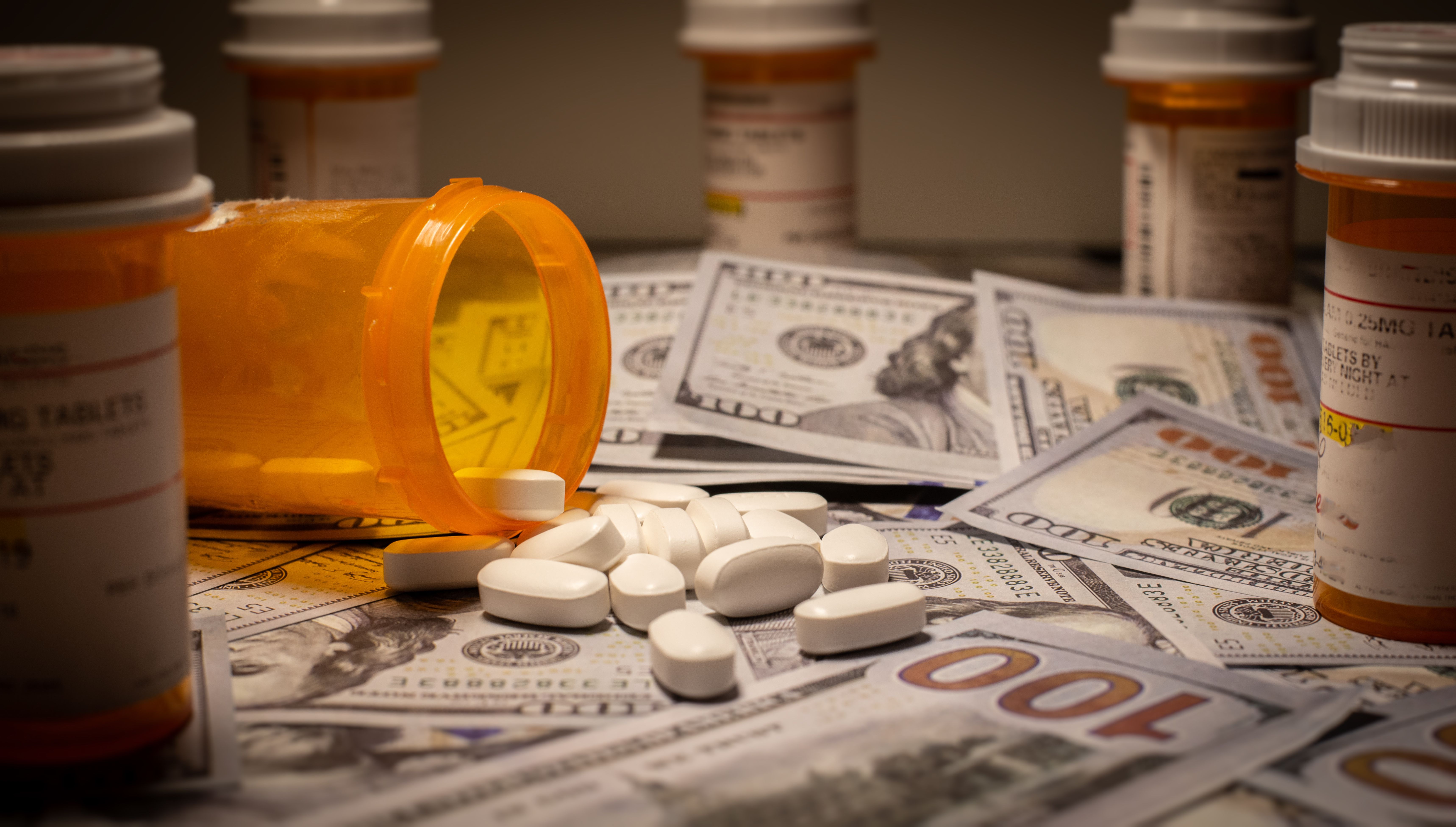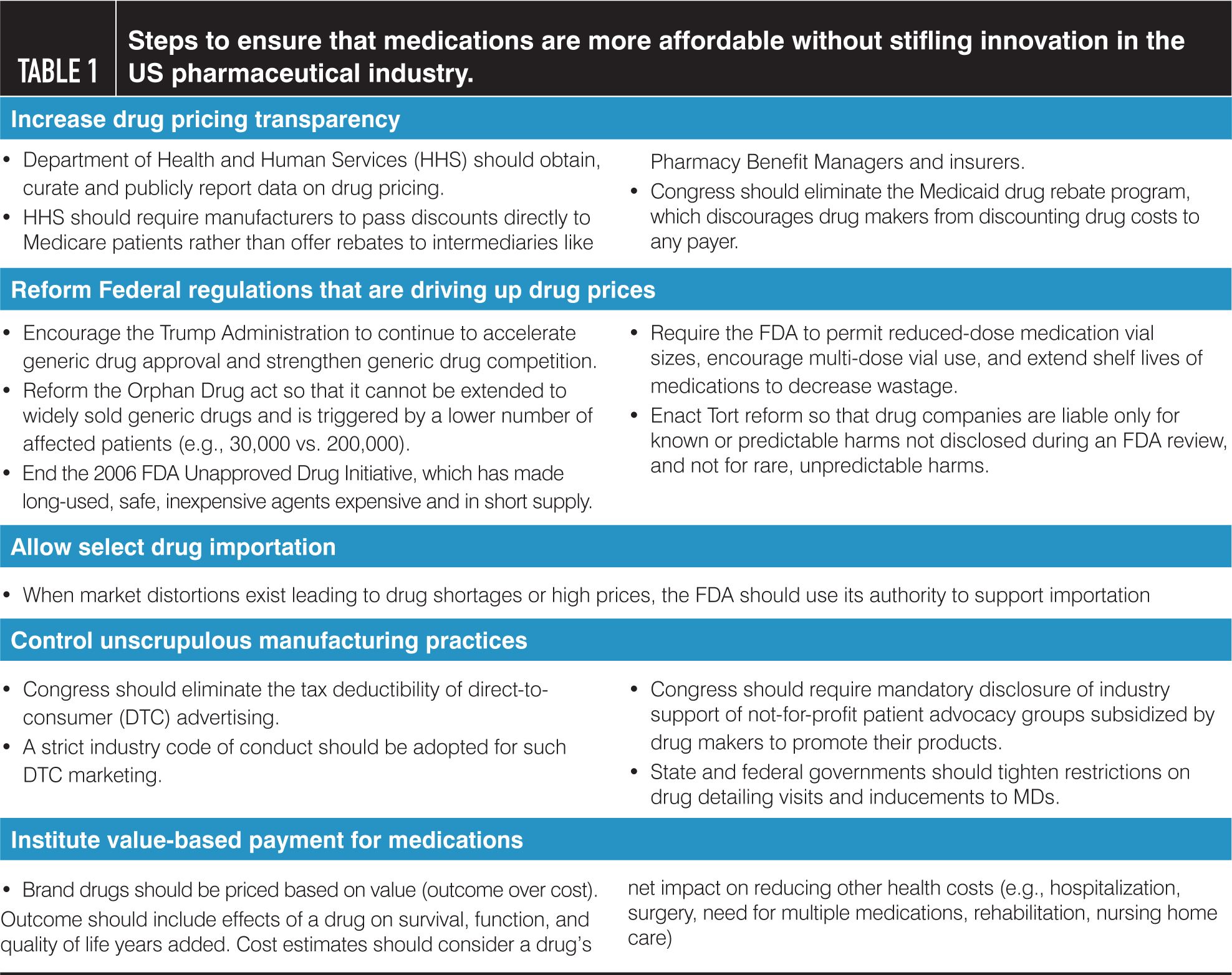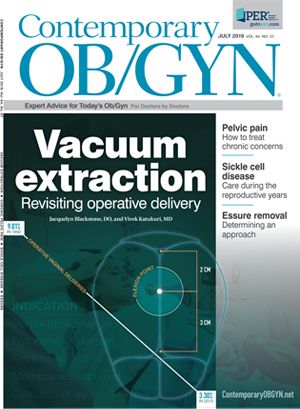Ensuring medications are more affordable without stifling innovation (Part 2)
In the second part of this series, potential solutions to fix the rising drug cost problem are examined.
©Darwin Brandis - stock.adobe.com

Charles J. Lockwood, MD

Table 1

In my prior editorial on this topic, I reviewed the principal reasons why prescription medications in this country are so costly. I pointed out that the “market” in prescription drugs is grossly distorted by opaque pricing, costly intermediaries, price inelasticity and a lack of consumer control as well as manufacturer rebates, direct-to-consumer advertising and co-pay coupons. I also noted that brand drug makers are free to set their own prices, which in the case of specialty drugs can be astronomical (e.g., spending on just Humira exceeded $10 billion in 2015).1
To make matters worse, when patents expire, manufacturers can delay conversion of their costly brand drugs to less expensive generics through “product hopping” and “ever-greening.” But even after generic transitions occur, limited competition frequently permits generic manufacturers to achieve effective monopolies, sustaining high prices. Well-intentioned government regulations (e.g., Orphan Drug Act) designed to promote innovation have had disastrous unintended consequences for drug prices. Medicare’s inability to negotiate drug prices or import inexpensive foreign drugs also drive up costs. And then there are the financial incentives that drug companies dangle in front of physicians to prescribe high-cost medications. While the sheer complexity of the problem is daunting, there are simple steps that the Federal government could take to restrain prescription drug costs without restraining the extraordinary innovation that is the hallmark of the US pharmaceutical industry (Table 1).
Increase drug pricing transparency
Many stakeholders from the National Academy of Medicine (NAM) to the Trump Administration have advocated for greater transparency in the various financial flows and profit margins within the drug supply chain (e.g., manufacturers, pharmacy benefit managers [PBMs], and retail, wholesale and 340 B-eligible hospital pharmacies).2,3 For example, a patient goes to her pharmacy to pick up a prescription drug and, if the drug is covered by an insurer, likely has a co-pay. Subsequently the manufacturer sends a rebate to the PBM hired by the patient’s insurer to negotiate prices. The PBM, after retaining some of the rebate, passes the remainder on to the insurer, which often uses it to offset premium costs to retain customers. This incentivizes higher drug costs since patients will potentially pay exorbitant sums for a drug their physician says they need but manufacturers’ rebates go to intermediaries and not to the patient. Worse, all these transactions are cloaked in secrecy in the name of market competition.
Requiring drug makers to publish their prices and rebates would expose the true costs of intermediaries and likely exert downward pressure on pricing due to improved market efficiency. The NAM has proposed that the Department of Health and Human Services (HHS) obtain, curate, and publicly report drug pricing data (e.g., list prices, rebates, discounts, net prices) on a quarterly basis, conduct analyses of these data, and inform the Food and Drug Administration (FDA) and Federal Trade Commission (FTC) of possible abuses.2 Beyond the “dog shaming” impact of such reporting on drug pricing, this would likely fuel meaningful antitrust actions to enhance market efficiency.
In a more radical disintermediation step, this January, HHS proposed modifying Medicare Part D rules to require manufacturers to pass discounts directly to Medicare patients at the pharmacy counter rather than indirectly, through rebates to intermediaries like PBMs.4 Currently Medicare patients are not eligible for manufacturers’ patient assistance plans because of federal kick-back restrictions but perversely, rebates to intermediaries are allowed. While this proposal holds great promise for reducing individual patient drug costs and seems inherently more just, it does risk increasing Part D premiums and reducing pressure to switch to generic or biosimilar specialty drugs.4 Similarly, Congress should eliminate the Medicaid drug rebate program, which discourages drug makers from discounting drug costs to any payer since it would increase the cost of their rebate to Medicaid.
Reform Federal regulations that are driving up drug prices
The Trump administration has accelerated FDA approval of generic drugs with over 1000 new approvals in 2017 potentially saving $9 billion.3 Moreover, it is seeking to close loopholes used by brand drug makers to restrain generic competition. More importantly, HHS is seeking authority to increase Medicare’s ability to negotiate drug prices. These actions deserve robust bipartisan support. I believe strongly that there is an urgent need to apply the full weight of US government drug purchasing power to negotiate drug prices for both Medicare and Medicaid and create a national formulary like those used by most other industrialized nations.
There is need to reform the Orphan Drug Act of 1983.2 First, financial incentives for prevention and treatment of rare diseases should not be extended to widely sold generic drugs (e.g., 17-hydroxyprogesterone caproate). Second, reducing the patient number threshold defining an “orphan” disease from less than 200,000 to a more reasonable number (e.g., 30,000) would have an immediate beneficial effect on costs. I would also advocate ending the 2006 FDA Unapproved Drug Initiative, which was designed to bring grandfathered medications under stricter control but has resulted in substantially higher prices, on average 37% higher, and frequent drug shortages.5
Other simple regulatory actions with potentially major economic benefits include having the FDA permit reduced-dose medication vial size, encourage utilization of multiuse vials, and significantly extend the recommended shelf lives of medications to decrease wastage. The latter is particularly egregious as the designated shelf life of drugs is often not evidence-based and frequently grossly underestimated.6
Finally, we need Tort reform. Drug companies should be liable only for known or predictable harms purposefully not disclosed during an FDA review, and not for rare harms undetectable during Phase 1 to 3 clinical trials. Reducing such liability costs could have a demonstrable effect on drug pricing.2
Allow select drug importation
Because foreign governments effectively negotiate with US drug makers for lower prices and many of the components of U.S. medications are manufactured abroad, there is an inherent logic to allowing drug importation. The FDA has pointed out drugs manufactured in a foreign country for the US market are produced in FDA-registered plants that also make drugs sold (at far lower prices) in other countries, an implicit indicator of drug safety.7 However, there are risks to unrestrained importation. A substantial number of drugs imported via the Internet have been reported to be less effective or ineffective and/or to contain impurities or toxins.8 Thus, FDA oversight would be needed for any such program, which would add costs. Califf and Slavitt have argued that when market distortions exist leading to drug shortages or high prices, the FDA should use its authority to support importation.9 This seems like a very reasonable middle ground.
Control unscrupulous manufacturing practices
There is no doubt that direct-to-consumer (DTC) advertising works or we would not be flooded with the vast number of ads we see on television touting high-cost specialty drugs that clear skin, prevent clots, or permit quicker recovery from chemotherapy. Most come with the offer of a manufacturers’ patient assistance plan or co-pay coupons (if commercially insured) which reduces patient out-of-pocket expenses for costly brand drugs but also reduces use of inexpensive generic drugs by 60%.2 While First Amendment protections likely make it impossible to ban such advertising, Congress should eliminate the tax deductibility of DTC advertising and an industry code of conduct should be adopted for such marketing. Similarly, Congress should require mandatory disclosure of industry support for not-for-profit patient advocacy groups, which are often heavily subsidized by drug makers to promote their products.2 Finally, it should tighten restrictions on drug detailing visits and inducements to MDs.
Institute value-based payment for medications
Health care financing is evolving from a fee-for-service system that incents volume to a value-based payment (VBP) system that rewards better outcome for lower costs. Prescription drug pricing should also be based on a VBP paradigm.9 Pricing of brand medications should consider the high development costs and substantial financial risks manufacturers incur to bring new drugs to market (e.g., 90% of new drugs fail to reach market approval). Indeed, patent protections permit exclusivity to sell novel drugs as a hedge against such development risks, but such exclusivity should not be a license for unrestrained pricing. Rather, brand drug pricing should also be based on value-effects of a drug on actual outcomes (e.g., survival, improved function, and quality of life years added) over cost. A drug’s impact on aggregate health costs (e.g., need for hospitalizations, surgery, multiple medications, rehabilitation, and nursing home care) should also be considered in price determinations. While these measurements are complex and require time to calculate, the 21st Century Cures Act of 2016 should help fund federal agencies that can make such calculations. In the end, VBP for drugs is likely the most effective way of restraining medication costs without restraining innovation.
Take-home message
America should be justifiably proud of the incredible discoveries and innovative therapies that its pharmaceutical industry has produced, often in concert with medical school researchers. However, prescription drug costs in this country are far too high and rising at many multiples of the rate of inflation. These costs threaten the financial viability of Medicare, Medicaid and indeed, our entire health system. Our system also burdens American families with high out-of-pocket costs. There are many causes of this crisis, including an opaque and distorted pharmaceutical market, perverse government regulations, unscrupulous marketing techniques, and a failure to leverage the federal government’s vast negotiating leverage. Fortunately, there are some very straightforward steps that can be taken to lower costs without impeding innovation. These include measures to increase price transparency to restore market forces, reform of well-meaning Federal regulations whose unintended consequences are paradoxically inflating drug prices, eliminating or at least restraining unscrupulous marketing practices, and ultimately transitioning to a VBP system for medications.
References:
1. Dana KN, Hertig JB, Weber RJ. Drug pricing transparency: the new retail revolution. Hosp Pharm. 2017 Feb;52(2):155-159.
2. Augustine NR, Madhavan G, Nass SJ (editors) National Academies of Sciences, Engineering, and Medicine. 2018. Making medicines affordable: A national imperative. Washington, DC: The National Academies Press.
3. US Department of Health and Human Services. American patients first: The Trump administration blueprint to lower drug prices and reduce out-of-pocket costs.
https://www.hhs.gov/sites/default/files/AmericanPatientsFirst.pdfAccessed April 20, 2019.
4. Gellad WF, Ennis M, Kuza CC. A new safe harbor - turning drug rebates into discounts in Medicare Part D. N Engl J Med. 2019 May 2;380(18):1688-1690.
5. Gupta R, Dhruva SS, Fox ER, Ross JS. The FDA Unapproved Drugs Initiative: an observational study of the consequences for drug prices and shortages in the United States. J Manag Care Spec Pharm. 2017 Oct;23(10):1066-1076.
6. Allen M. The myth of drug expiration dates. ProPublica. https://www.propublica.org/article/the-myth-of-drug-expiration-dates Accessed May 26, 2019.
7. Horvath JC, Anderson GF. The states as important laboratories for Federal prescription drug cost-containment efforts. JAMA. 2019 Apr 23;321(16):1561-1562.
8. Blackstone EA, Fuhr JP Jr, Pociask S. The health and economic effects of counterfeit drugs. Am Health Drug Benefits. 2014 Jun;7(4):216-24. Review.
9. Califf RM, Slavitt A. lowering cost and increasing access to drugs without jeopardizing innovation. JAMA. 2019 Apr 23;321(16):1571-1573.

SART data indicates rise in IVF use in 2022
April 24th 2024Dive into the latest statistics from the Society for Assisted Reproductive Technology, revealing a 6% increase in in vitro fertilization cycles and a surge in egg freezing, amidst a landscape of rising fertility service demand and evolving clinical practices.
Read More
Study finds antihypertensive treatment reduces uterine fibroids risk
April 23rd 2024A recent study revealed that patients with untreated or new-onset hypertension face elevated chances of uterine fibroid diagnosis, underscoring the potential of antihypertensive therapy in mitigating this risk among midlife individuals.
Read More
